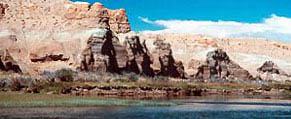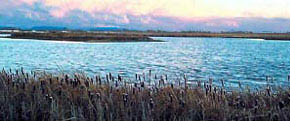Over the last several decades, increases in human population, recreational activities, and industrial and residential development have dramatically changed the social and economic context within which public lands are managed. Today, we recognize that people are part of the ecosystem, and a comprehensive understanding of human-ecosystem relationships across a range of spatial and temporal scales is essential for effective natural resource management. Consequently, socioeconomic research and data in relation to biological and natural resource management have grown in importance and application. The USGS Biological Resources Discipline is home to a unique group of scientists with the expertise to integrate human knowledge, values, and perceptions of ecosystem management into practical management strategies.
 |
|
USGS scientists are helping to integrate scientific data pertaining both to biology and visitor use in refuge comprehensive planning goals. (John and Karen Hollingsworth/USFWS) |
 |
Seedskadee National Wildlife Refuge, Wyoming, courtesy of USFWS. |
 |
|
Monte Vista National Wildlife Refuge, Colorado, courtesy of USFWS. |
The Policy Analysis and Science Assistance Program (PASA) of the Fort Collins Science Center is dedicated to studying the relationship between humans and the environment. PASA scientists conduct and integrate biological, social, and economic analyses so that resource managers can use the resulting information to make informed decisions and resolve resource management conflicts. Their objective is to conduct studies that seek to understand how humans are affected by environmental management decisions and how human activities interact with natural resource management.
Two long-term partnerships demonstrate the ways in which PASA scientists are assisting resource managers in meeting their mandates. PASA scientists are working with the U.S. Fish and Wildlife Service (FWS) and U.S. Bureau of Land Management (BLM) to help ensure that their Comprehensive Conservation Plans and Resource Management Plans are developed using a strong scientific foundation.
The 1997 Refuge Improvement Act mandates that the FWS develop Comprehensive Conservation Plans for the 540 units of its National Wildlife Refuge System. The Act and subsequent FWS policy require the use of the best available science in refuge management. A specific goal of the planning effort is to "support management decisions and their rationale by using a thorough assessment of available science." PASA scientists have worked closely with FWS refuge biologists and planners to integrate scientific data into the goals and objectives of these comprehensive plans. This has been accomplished through workshops at the refuge level, publication of technical reports, training and workshops at both regional and national levels, and development of visitor use surveys. Other USGS Centers have assisted the FWS in their planning efforts as well, including the Northern Prairie Wildlife Research Center, Patuxent Wildlife Research Center, and the Upper Midwest Environmental Sciences Center. These Centers have provided on-site workshops, geographic information systems products, and assistance with design and implementation of species and habitat monitoring programs. Together with PASA, these USGS scientists are filling an important role in helping refuge managers to develop science-based goals that also incorporate the human element.
In another example, PASA scientists have conducted research to support BLM partners at Colorado Canyons National Conservation Area (CCNCA) in developing their Resource Management Plan (RMP). The RMP for each National Conservation Area contains an analysis of social and economic conditions and evaluates social and economic results from likely management scenarios. The manager and planning staff of BLM Conservation Areas are responsible for including these social and economic assessments in such a way that understanding these factors aids planning decisions and helps guide management actions.
In the fall of 2002, PASA scientists met with the staff of the Colorado Canyons National Conservation Area to discuss the issues related to social, economic, and human dimensions of natural resource management as it related to the RMP planning process. As a result of this meeting, a combination of studies was designed to evaluate how humans are affected by environmental management decisions and how human activities influence natural resource management. The purpose of the PASA study was to assess the attitudes of visitors to public lands in the CCNCA toward the introduction of user fees. To this end, we conducted a series of surveys at the CCNCA relating to recreation on public lands and the perceived impact of user fees in Mesa County, Colorado.
Through partnerships such as these with sister DOI bureaus,
the USGS can offer expertise such as that found within the PASA team to
research and evaluate all aspects of management decisions-including social
and economic considerations-so that resource managers can be confident
they are using the best available science to meet their management challenges
in a changing world.
Also at FORT:
Policy Analysis and Science Assistance Program
USGS-BRD Advising on Refuge Comprehensive Conservation Plans
For more information, contact: